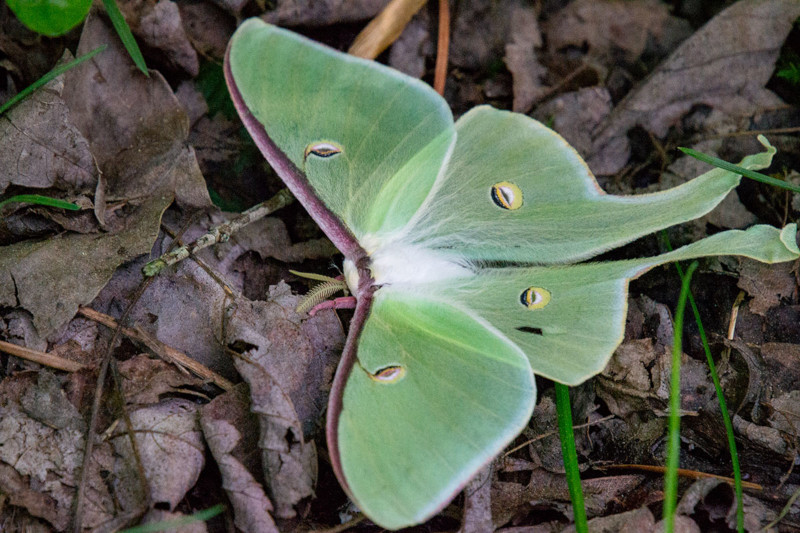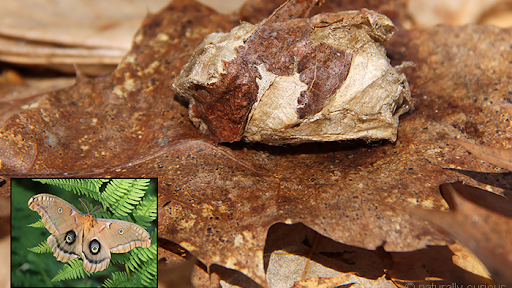November 21, 2024

Photo: Sebastian Alejandro Echeverri
Written by HCWG's Linden Hickson
As autumn settles in, many of us feel compelled to rake the fallen leaves that blanket our lawns. However, I am here to challenge you to think of that litter as a friend instead of a chore. It’s not trash–it’s an important part of the ecosystem. This decaying organic matter has an array of benefits for your plants, the soil, and beautiful creatures such as the Luna moth pictured above. Instead of bagging these leaves and sending them to the landfill or compost, leave the leaves!
While it may be (considered) unsightly, leaves provide important habitat for thousands of overwintering invertebrates. Decomposers like millipedes, rollie pollies, beetles, and earwigs need it. Microorganisms like springtails need it. Beautiful friends like sphinx moths, stick insects, bees, and fireflies need it too. By leaving the leaves, your garden will have many unique pollinators next year! If you don’t care about bugs, think instead of all the birds you’ll be feeding. Many birds rely on these critters to feed their young in the spring.
Additionally, these leaves are free mulch and free compost. It’s beneficial to leave a thin layer over your grass. As these leaves sit and break down, they feed your lawn, suppress weeds, and improve the soil composition below (which means less watering next summer!). If you don’t like looking at the “mess,” you can rake this leaf litter into flower beds or bare sections of the yard. It will help insulate any dormant perennials you have. I would avoid shredding the leaves since this will disrupt any insects that have already settled in. The leaves will break down naturally (with the help of your new insect friends) within a season or two.
The same logic applies to fallen limbs and any perennial material you’ve cut back. Pile this up in an area of the yard and let it rest. If you don’t have room or the ability to store all of the limbs, sticks, and leaves, that’s okay. Leave what you can for as long as you can! If you want to rake the leaves after winter is over, wait until temperatures warm up. You’ll give these insects a chance to hatch if you wait until April.
If you move the leaves, be gentle when you’re raking, and avoid using a blower. Keep a lookout for signs of life–holes in the ground may be home to bumblebees or other beneficial insects. It is best not to disturb these nests, so leave the leaves in that section. You may also find moth or butterfly cocoons or pupae. These are often well-camouflaged, which is why it’s important to be gentle. You can pick up these pupae and move them to the area where you’re putting the leaves.
In a similar vein, we recommend you wait to cut back your perennials until early spring. Dry seedheads feed the birds, some insects like leafcutter bees nest in the hollow stems of dormant plants, and this material offers another level of insulation for your plants, blocking windchill and preventing frost from settling.

Bumblebee nest

Polyphemus Moth cocoon
Photo: Mary Holland
Disclaimer: if you’ve had any fungal problems or other disease issues this year, you should make an exception for that material. To [help] end that cycle of disease, you want to prevent those pathogens from overwintering in your garden. Discard this material in your city compost bin or paper bags in the trash bin with the lid closed. The city compost will cook plant pathogens out of that material, whereas your backyard compost may not. If we have to send it to the landfill, we want to give it the ability to break down when it gets there, so avoid plastic bags.
Want to help spread the word? The Xerces Society recommends posting online and using the hashtag #LeaveTheLeaves. Here are some graphics they’ve provided. They also sell signs for your yard, so you can explain it to your neighbors!
Interested in learning more about what you can do to help our native insects? Check out these other posts.
https://hillcountrywatergardens.com/creating-a-pollinator-paradise/
https://hillcountrywatergardens.com/our-top-5-unusual-native-trees-for-central-texas-landscapes/
What are you going to do with all of this free time you’ve gained by leaving the leaves? Find out here!
https://hillcountrywatergardens.com/november-to-do-landscape-garden/


You must be logged in to post a comment.